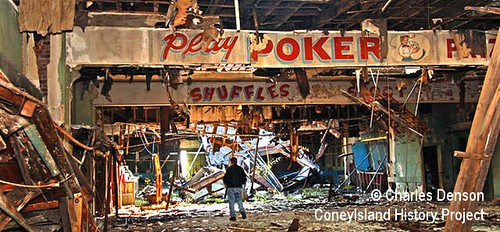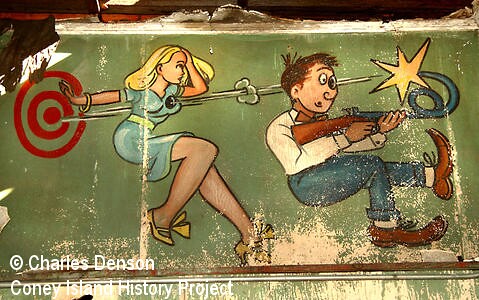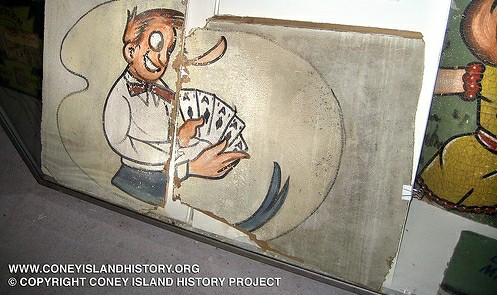"The Curious Playland Arcade Art of Larry Millard" will be on view at the Coney Island History Project from May 25 through Labor Day 2013, Saturdays, Sundays and holidays, from 12 noon-6pm. The exhibit of photo documentation and several examples of original artwork being restored is open to the public free of charge. The History Project's exhibition center is located under Deno's Wonder Wheel Park's iconic entrance sign at 3059 West 12th Street, just a few steps off the Boardwalk.
The mural-covered interior of the Playland Arcade on Coney Island's Surf Avenue delighted patrons for many decades yet few knew the story behind the colorful artwork that covered every inch of the establishment. Playland closed in 1981 and the building stood empty until it was demolished in 2013. The Coney Island History Project's multi-year mission to save and document the unusual murals inside the Playland Building ended successfully on February 14 with the removal of several of Larry Millard's iconic artworks and the remaining letters from the Bowery entrance's neon sign hours before demolition.
Previously saved murals were displayed at the Coney Island History Project's exhibit center last year. We worked with Gateway Demolition to remove several of the murals just before demolition. Our previous efforts at preservation were hampered by trespassers, vandals, black mold, the untimely death of Playland's caretaker, Andy Badalamenti, as well as Superstorm Sandy, but finally the story of the artist who created them can be told. 
In the winter of 1957 a mysterious unemployed artist named Larry Millard showed up at the Playland Arcade on Surf Avenue looking for work. Forty-five-year-old Millard claimed to have been a cartoonist for the New York Daily News and offered his services as a sign painter. Playland owner Alex Elowitz hired him to paint some small lettered Skeeball signs. His lettering was perfect and he continued working at the arcade through the summer of 1958 painting large and colorful and murals on every inch of wall space.
Millard followed a daily routine, arriving early in the morning unshaven and smelling of alcohol, suffering from the shakes. He was given a couple of bucks for a bottle of Thunderbird wine that he bought at the liquor store across the street next to Mama Kirsh's restaurant. The drink steadied his hand, enabling him to paint.
Stanley Fox, who worked at the arcade owned by his brother, described Millard as "artsy-looking," with dark hair and a mustache, always wearing a Fedora and usually accompanied by his girlfriend, an African-American woman named Eunice. Millard would arrive daily with sketches to be approved by Elowitz. "My brother paid him by the day, maybe $25. Larry lived somewhere in Coney Island, although no one was sure where."
Millard's Skeeball signs led to the complex cartoons he illustrated with puns and jokes: busty, leggy women with hapless boyfriends. Many of his murals were in the cartoon style of Lil' Abner creator Al Capp. The public loved his work and he continued painting Playland until every wall was filled. When Millard finished his murals at the Playland building he began painting outdoor signs around Coney Island, and murals at Stauch's and at the B&B Carousell.
Millard disappeared from Coney Island around 1960 and was never seen again. He left a mark much like native petroglyphs: deceivingly simple yet undecipherable and opaque. His work is mysterious and edgy, erotic and "cartoony." When you look past the inherent humor in his pieces it's possible that most of his sketches were sad self-portraits telling his life story: the portrait of a tortured soul who had bad luck with women. --- Charles Denson



Add new comment